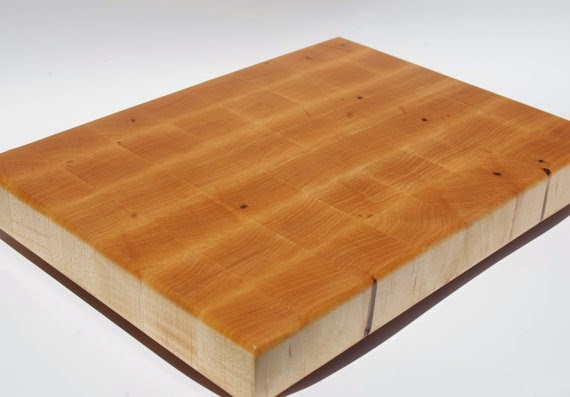I have thing for sharp knives: Japanese knives, especially, because who can resist the lore of a family of swordsmen who moved into making knives after the decline of the sword market? How often do you get to use the phrase “sword market”? On my Facebook page, you’ve probably noticed that I frequent a Japanese knife merchant at a local farmer’s market, where I often slice more than a salad’s share of tomatoes and document my unhealthily long wish list of knives. I must be descended from swordsmen, most probably the royal type, which must render me too noble for housework, right?
Til that theory is validated, I’ll have to keep cooking my own meals and for that, I like sharp knives. Which is why I invested recently in some end grain cutting boards. The young apprentice and I made a quick video for you above telling you what to look for and how to care for end grain boards.
***Update: some of you have let me know that the subscribe button in the video doesn’t work when you’re on a mobile device! So if you’d like to subscribe to our YouTube channel, just click here: http://www.youtube.com/channel/UCS3uHNur9XG60vG0LbHoMHw?sub_confirmation=1 . Thanks! ***
End grain boards (also often called butcher blocks) are boards made up of blocks of wood cut against the grain. When you cut into an end grain board, the individual wood fibers bend away from the blade, providing less resistance and thus prolonging the sharpness of your blade. These boards are more expensive than other types of boards typically, but a quality board should
Here’s what you need to know:
- Get a board that’s made of maple or walnut. They have the right balance of strength and flexibility to last you a long time. There are cheaper, acacia board out there but the wood is harder and therefore tougher on the knife blade.
- Given a choice, definitely get rubber feet put on your boards. This not only prevents the board from slipping, but also ensures that it doesn’t sit in standing water. Your board is basically blocks of wood glued together, so prolonged exposure to water not only loosens the glue, but can cause warping on your board.
- Ditto for the top side of the board – avoid prolonged exposure to liquids, and always wipe down the surface of the board after chopping or rinsing. I use a mild detergent just to scrub the surface but don’t leave the water on for long before wiping down with a dish towel.
- After some use, your board will start to whiten in some areas, where the sealant has worn away. When your board is dry, rub it with some walnut oil (see video above) and then let it cure. Don’t use olive or canola oil, as they go rancid; mineral oil is another popular option. Make sure whatever oils you use are food grade.
When I shopped around for boards, I found a fantastic selection from individual artisans on Etsy. I decided to get one board for fruit, one for veggies and a third for meat. My favorite board was a maple one from Etsy seller Live Grain Designs, which offered beautiful workmanship and quick turnaround time. I also have a walnut one from End Grain Up that is excellent — and he does custom work.
Do ensure that you’re getting an end grain and not edge grain board though — edge grain is less expensive, and doesn’t have the same give of the fibers when you cut in. Here’s a good link describing the difference between the two.


The best knife sharpening I’ve found is with the Japanese knife merchant at my local market – he does it by hand and the blades come back scary sharp. I’ve used some sharpeners who use machines too – but I’m kind of precious about my Japanese knives so I haven’t taken them to a machine yet. Definitely comment and let me know if you have any great tips on how to keep knives sharp!





 Home
Home